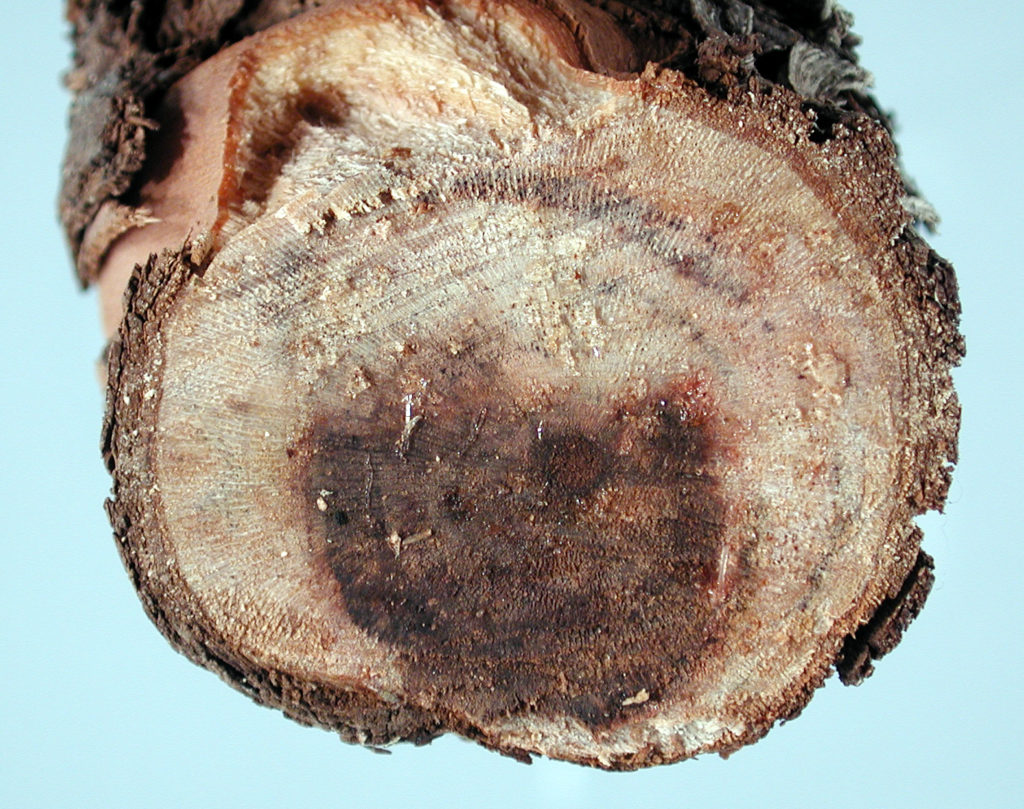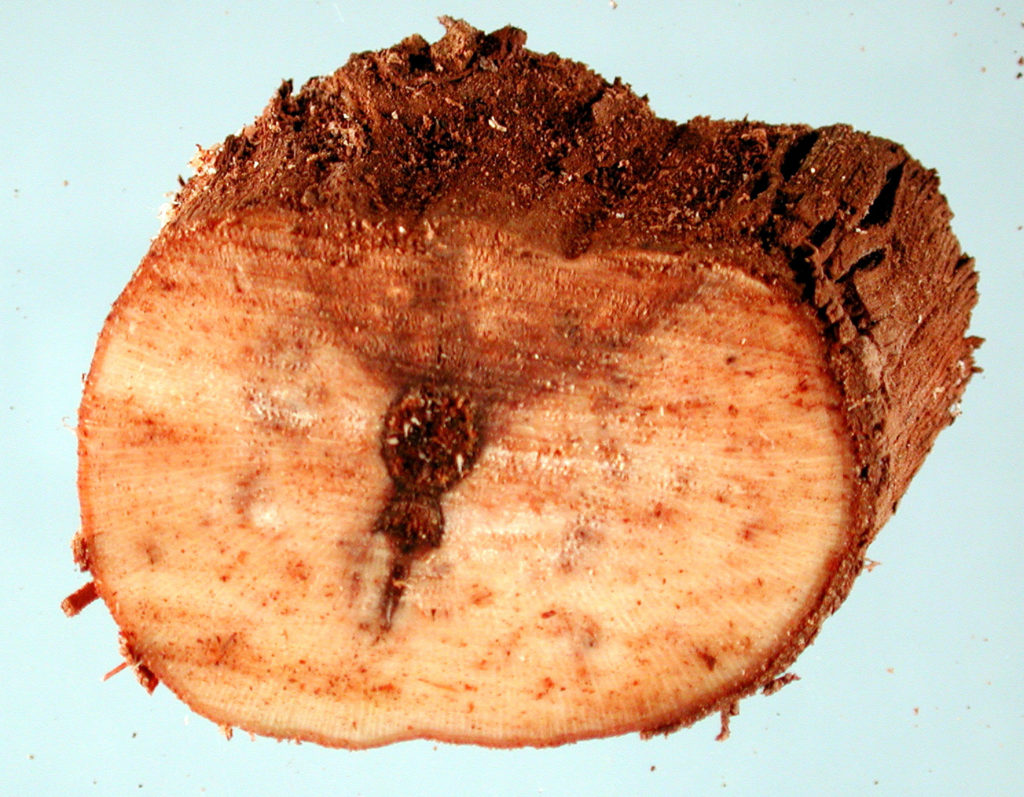Esca and Young Vine Decline: What you should know.
One of the wisest things ever told to me was “If you can’t get out of it, get into it”. This phrase came into my life while working a boring summer job as an angsty teenager almost two decades ago and since then I have never once retired it. We do, after all, deal with a fair number of unpleasant things in agriculture. Disease, for instance, sucks. But if I had to really “get into” one of them, Esca is my fave.
Why? Well for starters it’s mysterious. When I lived in Italy, Esca was right up there with Flavescenza (a.k.a. flavescence dorée) as far as reasons to pull a vine. This is because Europe hosts the more severe, “apoplexy” version of the disease and I definitely saw vines go from healthy to toast in the matter of a season. In California, you see more muted symptoms on fruit with occasional leaf symptoms. Some years it makes an appearance only to disappear the year after. This disease is attributed to a complex of fungi, all of which are present in most vines older than five years healthy and sick alike. Why then do symptoms pop up sometimes and not others? Why is it so much tougher in Europe? I don’t really think we know everything there is to know about Esca, and sigh, I find that intriguing (eyelash flutter).
Second of all, it’s so darn pretty. Leaves turn from green to purple, pink, red, and orange. In Italian the term is “tigrate”, literally “tiger-ed”. I think that’s pretty accurate at least until the vine crisps up and dies. Perhaps William Blake was a viticulturist, or perhaps, you know, not.

Who are the main players?
In older vines, Esca has been attributed to the fungi Phaeomoniella chlamydospora and Phaeoacremonium minimum (although there are other species of Phaeoacremonium indicated). Infection from these pathogens is followed by various basidiomycete fungi.
Young vines, afflicted with what is known as Young Vine Decline are infected with a more complex fungal cocktail. Phaeomoniella chlamydospora and Phaeoacremonium sp. are still major contributors. Pleurostoma richardsiae, and species of Cadophora such as Cadophora luteo are also in the mix.
What causes it?
The Grapevine recognizes these pathogens as foreign and produces a black mucous called tyloses that clog the vascular tissue in an effort to isolate the infected area. Starving tissue of water and nutrients (In addition to downregulation of photosynthesis and activation of defense-related genes) brings about the characteristic striped leaves. If the infection is bad enough, complete occlusion of the xylem causes necrosis, sometimes of the entire vine. If you cut an infected vine open, you can see the black tyloses filling the vascular tissue. This has been referred to as “black goo” (initially by viticulturist Lucy Morton). Note that it looks very different from the “pie slice” you typically see with Eutypa.


There is some evidence that environmental stressors trigger the appearance of symptoms. While that can be said for any disease (a sick plant is more sensitive to pathogens), I believe with Esca it’s particularly true. The aforementioned fungi have been present in grapevines for millennia and if you test a vine older than five years, you’re likely to find that at least some if not all of these microorganisms are present.
Fischer and Kassemeyer (2012) found that water-stressed vines were much more affected by P. chlamydospora than well-watered specimens. This makes sense. When I was in Italy, Esca tended to pop up more during dry years. However, we’re two years deep into one of the worst droughts in 100 years here in California and for the most part Esca incidence hasn’t changed.
What can you do about it?
Esca is considered a trunk disease and at least according to the Italians, it should be dealt with in the same way you would deal with Eutypa or Botryosphaeria dieback. Avoid making large cuts during pruning and don’t prune during periods of high humidity. Either seal your wounds or spray fungicide post-pruning. In places like Europe, where Esca is a much larger problem, mark symptomatic vines during the growing season and prune them separately from healthy vines. Personally, I’m not so sure Esca is really spread this way. I never saw symptoms straight up the vine row, as you would expect with a pruning-borne pathogen. Rather I’d see them appear here and there with no apparent pattern. Still, taking precautions while pruning are always prudent (see what I did there?), especially in a place like California where Eutypa is far more prevalent.
Like all trunk disease, cane pruning leaves the vines less susceptible than spurred-cordon. There’s just less wood hanging around and less susceptible tissue. This might not be an option for some growers. Cane pruning is a pain in the neck for some, but it does lead to healthier vineyards long term.

While Esca may be something we just have to live with in older vineyards, you can be proactive about avoiding Young Vine Decline. Early fungicide dips in the nursery have been shown to reduce the incidence of Esca in new plantings. Be sure you kick the tires when it comes to selecting a nursery. Some are more vigilant than others and starting out with bad planting material can be extremely costly.
Young Vine Decline is also exacerbated by abiotic stress. Therefore, you need to stay on top of nutrition via tissue sampling and appropriate fertilization. Don’t push production on young vines too soon. You don’t need to water stress them like older productive vines either. Make sure you give them enough water to keep them happy but not so much that their roots never feel the need to go deeper to look for water. This is the same advice I’d give you even if Esca wasn’t a problem.
Do any of you have experience with Esca? Anyone? Bueller? Feel free to tell us about it in comments or via email!
Citations:
Fischer, M., & Kassemeyer, H. H. (2012). Water regime and its possible impact on expression of Esca symptoms in Vitis vinifera: growth characters and symptoms in the greenhouse after artificial infection with Phaeomoniella chlamydospora. Vitis, 51(3), 129-135.
Gubler W.D., Eskalen A. (2008). Grapevine Nursery Practices and Effects on Petri Disease and Young Esca. Proceedings of the 2nd annual national research conference. July 9-11, 2008. P. 34.
Grape (Vitis spp.)-Esca, Young Esca, and Petri Disease. (2021, March 26). Pacific Northwest Pest Management Handbooks. https://pnwhandbooks.org/plantdisease/host-disease/grape-vitis-spp-esca-young-esca-petri-disease
WebDev, I. E. T. (2016, January 24). Young Vine Decline Frequently Asked Questions. UC Davis. https://www.ucdavis.edu/news/young-vine-decline-frequently-asked-questions.


